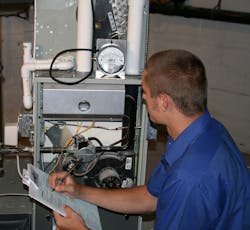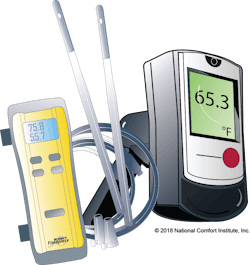You'll experience seasons of rapid advancement in your skills throughout your career from your training, on-the-job hard lessons, and mistakes. Let's look at an intentional way to build your testing and diagnostic skills by frequently questioning the readings on your test instruments.
Field Testing Realities
When you field testing a heating or cooling system, there are always irregularities that don't exist in a laboratory.
This reality of field testing will constantly challenge your judgment and skills. You have two choices when test results don't seem repeatable or disagree with related measurements. First, you can choose to doubt the test method and your test instruments. Or second, you acknowledge the challenges of field testing and work to understand and overcome these barriers.
Rigorous Balancing Hood Testing
From time to time, I hear from people who have failed to build trust in the accuracy of an air balancing hood. They dismiss this valuable tool altogether and migrate to far less accurate airflow test methods or stop testing altogether.
Sometimes you'll find hood settings don't match field conditions, or you forget to follow manufacturer instructions. I know because I became discouraged with some of these same challenges as I learned. Then I realized every testing obstacle has a solution.
Building your career comes from overcoming obstacles that don't always present an immediate solution. You can throw in the towel or dig in and discover valid solutions that improve your testing ability.
Let's face it; when you're testing a system, few people know what you're doing anyway. So, when a reading seems inaccurate, you're in a perfect place to build your confidence by continuing to test and diagnose until you discover why the measurement appears to be inaccurate.
Rather than surrender to your testing obstacle, learn more about test procedures, your instruments, and the field conditions that affect accuracy. Try related tests and instruments to dig for the answers you need. Inspect and test differently. Show some grit and stick with it. You can master the solution.
Temperature Measurement Challenges
Most of us are in the habit of installing a temperature test port near the airUnfortunately, a novice technicians' temperature testing skills may be far from accurate. Often, they install the temperature probe too close to the equipment, and the probe reads temperatures from the heat exchanger or cooling coil. This gives them a false reading. The result is a ΔT measurement that is artificially high. So they may conclude the system is operating well when it is not.
Air volume always affects temperature diagnostics in an HVAC system. If the airflow is low and ΔT is high, you may measure a perfect 20-degree drop in cooling mode, then assume airflow is perfect when it isn't close.
One fundamental principle of good HVAC diagnostics is to measure other related system properties that may affect the one you're focused on.
Static Pressure Measurement Obstacles
When a technician becomes NCI certified, they will hear the instructor caution them because one in 15 pressure tests results will be "goofy." We love tech support calls a few weeks after class when a technician or salesperson calls to report this exact situation. We ask them, "How do you know the pressure test is goofy?" The response is usually "the reading doesn't match field conditions… it's not right."
Only experience teaches this complete view of diagnostics.
The solution is often to install an additional test port six inches away and see if you can find a good reading. What's a good reading? Your experience and skill will be revealed when the reading agrees with other system measurements.
On the Job Training
Some of the best on-the-job training happens when you're alone. The best learning takes place when something you believe in is challenged. Many people avoid any challenge to what they know because it makes them uncomfortable.
The masters in our industry consistently challenge what they think they know by intentionally seeking better ways to look deeper and see more. They know that a dozen solutions often hide behind a problem. As soon as they find the solution to an immediate problem, they know a new problem they couldn't see before is next in line. And they're hungry to find it.
Years of Experience
Some in our industry boast of having five, 10, or 20 years of experience. Unfortunately, many learn most of what they know in the first year, become satisfied with that knowledge, and keep repeating what they think they know, year after year.
I find a consistent trait in each master technician, installer, salesperson, manager, or company owner who rises to the top of our industry. A curious nature drives them. They constantly strive to learn and discover what lies beyond what they currently know.
Some have always had it; for others, it came all at once in their career. But for most of our masters, curiosity and a drive to find answers grows as they exercise their talents and feed their desire to improve.
Very soon, maybe tomorrow, you'll be in a position to build your skills and question the readings on your test instruments. Would you consider more testing, inspection, and a higher level of diagnostics so you can jump to the next level in your career?
Rob "Doc" Falke serves the industry as president of National Comfort Institute, Inc., an HVAC-based training company and membership organization. If you're an HVAC professional interested in a free procedure about how to use a balancing hood, contact Doc at ncilink.com/ContactMe or call him at 800-633-7058. Go to NCI's website at nationalcomfortinstitute.com for free information, articles, downloads, and current training opportunities
About the Author
Rob 'Doc' Falke
President
Rob “Doc” Falke serves the industry as president of National Comfort Institute an HVAC-based training company and membership organization. If you're an HVAC contractor or technician interested in a building pressure measurement procedure, contact Doc at [email protected] or call him at 800-633-7058. Go to NCI’s website at NationalComfortInstitute.com for free information, articles and downloads.



